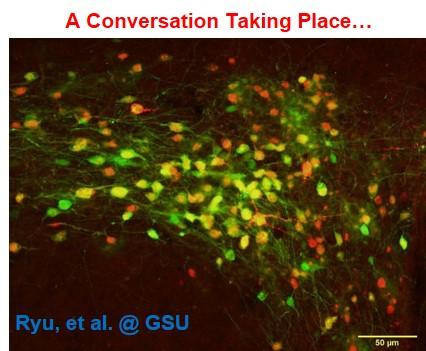Researchers discover how body's good fat tissue communicates with brain

These are sensory and sympathetic nerves connected to brown fat through the nervous system. Sensory nerves (red/orange) send information from fat to the brain and sympathetic nerves (green/orange) send the signal for fat to be activated or break down. Credit: Georgia State University
The findings, published in The Journal of Neuroscience, help to describe the conversation that takes place between the brain and brown fat tissue while brown fat is generating heat.
Brown fat is considered “good fat” or “healthy fat” because it burns calories to help generate heat for our bodies and expend energy, while white fat stores energy for later and can increase the risk for health issues, such as diabetes and heart disease. A person with a healthy metabolism has less white fat and an active supply of brown fat.
Studies show that brown fat plays a big role in someone having the capability to burn more energy, becoming a tool to stay trim and fight obesity. Pharmaceutical companies are trying to target brown fat and activate it more, said Johnny Garretson, study author and doctoral student in the Neuroscience Institute and Center for Obesity Reversal at Georgia State.
The study found that when brown fat tissue was activated with a drug that mimics the sympathetic nervous system messages that normally come from the brain, the fat talked back to the brain by activating sensory nerves. The sensory nerves from brown fat increased their activity in response to direct chemical activation and heat generation.
“This is the first time that the function of sensory nerves from brown fat has been examined,” Garretson said. “Brown fat is an active organ that's relatively important for metabolism, and we found a new pathway of its communication.
“The study informs us more about the communication between fat and the brain, which is really beneficial for treating human obesity. There is evidence that people with more brown fat have a better metabolism, lower instances of type II diabetes and are trimmer. Knowing how to increase the amount of brown fat activity or increase the brown fat, that's the future of trying to figure out yet another way to try and lose weight effectively and quickly.”
The researchers speculate that brown fat is telling the brain many things, such as how much heat is being generated, how much and what types of free energy are being used or stored, how much fat we have and how much fat we've lost.
“As brown fat gets hotter and starts to generate heat, being active and doing good things for our body, it increases our metabolism and helps us burn white fat,” Garretson said. “As it's getting hotter, Dr. (Vitaly) Ryu and other members of our lab found that it tells the brain it's getting hotter. We think this is some type of feedback, like a thermostat, and as it gets hotter, it probably controls how the brain is talking back to it.”
It was already known the brain communicates with fat tissue by telling it to break down and either release or use free energy for our bodies to function. This study shows a feedback loop between brown fat tissue and the brain.
The research team has studied the communication from fat to the brain and the brain to fat for years, but they're one of only a few labs in the world to examine communication from fat to the brain through the nervous system, Garretson said.
###
The research team includes Ryu, Garretson, Dr. Yang Liu, Dr. Cheryl Vaughan and Dr. Timothy Bartness, director of the Center for Obesity Reversal at Georgia State. The study is funded by the National Institutes of Health.
Media Contact
All latest news from the category: Life Sciences and Chemistry
Articles and reports from the Life Sciences and chemistry area deal with applied and basic research into modern biology, chemistry and human medicine.
Valuable information can be found on a range of life sciences fields including bacteriology, biochemistry, bionics, bioinformatics, biophysics, biotechnology, genetics, geobotany, human biology, marine biology, microbiology, molecular biology, cellular biology, zoology, bioinorganic chemistry, microchemistry and environmental chemistry.
Newest articles

First-of-its-kind study uses remote sensing to monitor plastic debris in rivers and lakes
Remote sensing creates a cost-effective solution to monitoring plastic pollution. A first-of-its-kind study from researchers at the University of Minnesota Twin Cities shows how remote sensing can help monitor and…

Laser-based artificial neuron mimics nerve cell functions at lightning speed
With a processing speed a billion times faster than nature, chip-based laser neuron could help advance AI tasks such as pattern recognition and sequence prediction. Researchers have developed a laser-based…

Optimising the processing of plastic waste
Just one look in the yellow bin reveals a colourful jumble of different types of plastic. However, the purer and more uniform plastic waste is, the easier it is to…



